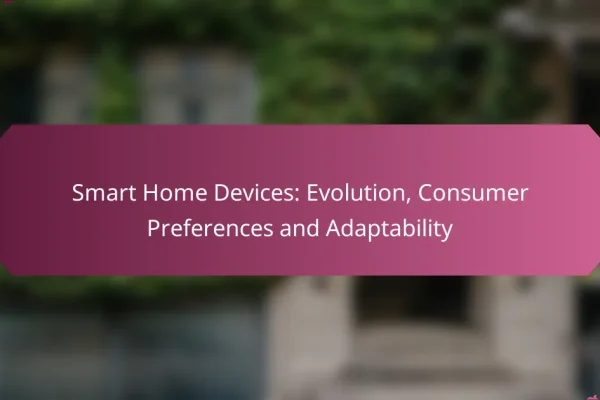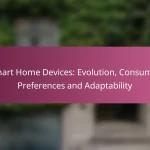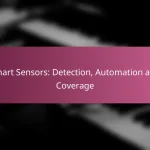What are the latest trends in smart home technology?
The latest trends in smart home technology focus on enhancing user experience through integration, efficiency, and security. Key developments include the use of artificial intelligence, energy-saving solutions, voice activation, advanced security systems, and improved connectivity among devices.
Integration of AI and machine learning
Artificial intelligence and machine learning are transforming smart home devices by enabling them to learn user preferences and behaviors. This integration allows devices to automate tasks, such as adjusting lighting or temperature based on the time of day or occupancy patterns.
For instance, smart thermostats can analyze historical data to optimize heating and cooling schedules, potentially reducing energy costs by a notable percentage. Users should look for devices that offer customizable AI features to enhance their home automation experience.
Increased focus on energy efficiency
Energy efficiency is becoming a priority in smart home technology, driven by both consumer demand and environmental concerns. Many new devices are designed to minimize energy consumption while maintaining performance, which can lead to significant savings on utility bills.
Examples include smart plugs that monitor energy usage and smart lighting systems that adjust brightness based on natural light levels. Homeowners should consider investing in Energy Star-rated products to ensure they are making eco-friendly choices.
Rise of voice-activated devices
Voice-activated devices are gaining popularity as they offer hands-free control over various smart home functions. Users can easily manage lighting, security, and entertainment systems through simple voice commands, enhancing convenience and accessibility.
Smart speakers, like Amazon Echo or Google Nest, serve as central hubs for voice control, allowing integration with multiple devices. When choosing voice-activated technology, ensure compatibility with existing smart home products for seamless operation.
Growth of smart security systems
Smart security systems are evolving with advanced features such as real-time monitoring, facial recognition, and remote access. These systems provide homeowners with enhanced safety and peace of mind, allowing them to monitor their property from anywhere via mobile apps.
Investing in a comprehensive smart security solution can include smart cameras, doorbell cameras, and motion sensors. It’s advisable to choose systems that offer cloud storage options for video footage and are compatible with other smart home devices for integrated security management.
Expansion of IoT connectivity
The Internet of Things (IoT) is expanding, connecting a wider range of devices within the smart home ecosystem. This connectivity allows for greater interoperability, enabling devices to communicate and work together more effectively.
Homeowners should look for devices that support common protocols like Zigbee or Z-Wave to ensure compatibility across different brands. As IoT technology continues to evolve, staying updated on new devices and standards will help maintain a cohesive smart home environment.
How do smart home devices enhance daily living?
Smart home devices significantly enhance daily living by automating tasks, improving security, managing energy use, and providing remote access. These technologies streamline household operations, making life more convenient and efficient.
Automation of household tasks
Smart home devices automate various household tasks, reducing the time and effort required for daily chores. For example, smart thermostats can adjust temperatures based on your schedule, while robotic vacuum cleaners can clean floors without manual intervention.
Consider integrating devices like smart lights that can be programmed to turn on or off at specific times, or smart speakers that can control multiple devices with voice commands. This automation not only saves time but also enhances comfort and convenience.
Improved home security
Smart home devices significantly enhance home security through features like real-time monitoring, alerts, and remote access. Security cameras and smart doorbells allow homeowners to see and communicate with visitors from anywhere via their smartphones.
Additionally, smart locks can provide keyless entry and allow users to grant temporary access to guests. These features help deter intruders and provide peace of mind, knowing that your home is monitored even when you are away.
Energy management and savings
Smart home devices contribute to energy management and savings by optimizing energy use throughout the home. Smart thermostats can learn your habits and adjust heating and cooling accordingly, potentially reducing energy bills by up to 20%.
Devices such as smart plugs and energy monitors can track energy consumption, helping you identify high-usage appliances. By making informed decisions about energy use, homeowners can lower their utility costs and reduce their environmental footprint.
Remote access and control
Remote access and control are key features of smart home devices, allowing homeowners to manage their systems from anywhere. Through mobile apps, users can monitor security cameras, adjust thermostats, and control lights while away from home.
This capability is particularly useful for ensuring home security and managing energy use when traveling. However, it is essential to secure these devices with strong passwords and regular updates to protect against potential cyber threats.
What are the top smart home devices available in 2023?
The top smart home devices in 2023 include a range of products designed to enhance convenience, security, and energy efficiency. Key players in this market are the Amazon Echo, Google Nest Hub, Philips Hue smart lighting, and Ring Video Doorbell, each offering unique features that cater to different needs.
Amazon Echo (smart speaker)
The Amazon Echo is a versatile smart speaker that utilizes Alexa, Amazon’s voice assistant, to perform various tasks. Users can control music playback, set reminders, and manage smart home devices through voice commands, making it a central hub for home automation.
When selecting an Echo model, consider the size and sound quality, as options range from compact versions to larger speakers with enhanced audio. The Echo Dot is popular for smaller spaces, while the Echo Studio offers superior sound for music enthusiasts.
Google Nest Hub (smart display)
The Google Nest Hub combines a smart display with Google Assistant, allowing users to interact visually with their smart home ecosystem. It can display weather updates, control compatible devices, and even show recipes while cooking.
One of its standout features is the ability to manage multiple smart home devices from a single interface. The Nest Hub is particularly useful for families, as it can be used for video calls and displaying photos, making it a multifunctional addition to any home.
Philips Hue (smart lighting)
Philips Hue offers a range of smart lighting solutions that can be controlled via smartphone or voice. Users can adjust brightness, change colors, and set schedules for their lights, enhancing both ambiance and energy efficiency.
When installing Philips Hue, consider the compatibility with existing fixtures and the need for a Hue Bridge for full functionality. The system supports various lighting scenarios, from cozy evenings to vibrant parties, making it a flexible choice for any setting.
Ring Video Doorbell (security)
The Ring Video Doorbell provides enhanced security by allowing homeowners to see and communicate with visitors at their door via a smartphone app. It features motion detection and night vision, ensuring visibility at all times.
When choosing a Ring model, consider the video resolution and whether you want features like two-way audio or pre-recorded messages. Subscription plans for cloud storage of video footage are available, providing an added layer of security for users.
What factors should you consider when choosing smart home devices?
When selecting smart home devices, consider compatibility with your existing systems, ease of installation, security features, and brand reputation. These factors will help ensure that your devices work seamlessly together and provide a reliable and secure smart home experience.
Compatibility with existing systems
Compatibility is crucial when choosing smart home devices. Ensure that the devices you select can integrate with your current home automation systems, such as smart hubs or voice assistants like Amazon Alexa or Google Assistant. Research the protocols used by the devices, such as Zigbee, Z-Wave, or Wi-Fi, to avoid connectivity issues.
To simplify your selection, look for devices that are labeled as “works with” your existing systems. This can save you time and frustration during setup and operation.
Ease of installation
Installation ease varies significantly among smart home devices. Some products require professional installation, while others can be set up in minutes by following straightforward instructions. Assess whether you are comfortable with DIY projects or if you prefer devices that come ready to use.
Check for user reviews that mention installation experiences. Devices with clear manuals and intuitive apps can greatly enhance your setup process, making it more enjoyable and less time-consuming.
Security features
Security is a top priority when choosing smart home devices. Look for features such as end-to-end encryption, two-factor authentication, and regular firmware updates to protect your network from vulnerabilities. Devices that provide security alerts or notifications can also enhance your peace of mind.
Be cautious with devices that lack robust security measures, as they may expose your home to potential hacking risks. Research the manufacturer’s security track record and user feedback to ensure you make a safe choice.
Brand reputation and support
Brand reputation plays a significant role in the reliability of smart home devices. Opt for well-established brands known for quality products and customer service. A good reputation often correlates with better support and product longevity.
Before purchasing, check for warranty options and customer support availability. Brands that offer responsive support channels can help you resolve issues quickly, ensuring your smart home operates smoothly.
How do smart home devices impact energy consumption?
Smart home devices can significantly reduce energy consumption by optimizing usage patterns and enhancing efficiency. They achieve this through automation, real-time monitoring, and remote control, leading to lower utility bills and a reduced carbon footprint.
Energy-efficient appliances
Energy-efficient appliances are designed to use less energy while performing the same tasks as standard models. For example, smart refrigerators can adjust their cooling based on usage patterns, while smart thermostats learn your schedule to optimize heating and cooling. These devices often meet or exceed standards set by organizations like ENERGY STAR, ensuring they consume less electricity.
Automated energy management
Automated energy management systems allow homeowners to monitor and control their energy usage in real-time. By using smart plugs and energy monitors, you can track which devices consume the most power and adjust their usage accordingly. This can lead to savings of 10-30% on energy bills, depending on the household’s habits.
Integration with renewable energy sources
Smart home devices can integrate with renewable energy sources, such as solar panels, to optimize energy consumption. For instance, smart systems can schedule high-energy tasks, like running a dishwasher, during peak solar production times. This not only maximizes the use of clean energy but can also reduce reliance on grid electricity, further lowering costs.




